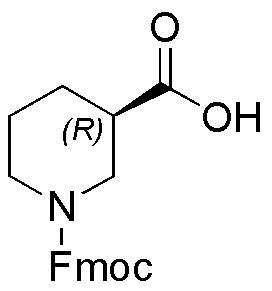Fmoc-D-nipecotic acid is widely utilized in research focused on:
- Peptide Synthesis: This compound serves as a protective group in the synthesis of peptides, allowing for the selective modification of amino acids without affecting others. Its stability under various conditions makes it a preferred choice among chemists.
- Drug Development: Researchers leverage its unique structure to design and develop new pharmaceuticals, particularly in the field of neuropharmacology, where it can influence neurotransmitter systems.
- Bioconjugation: Fmoc-D-nipecotic acid is used in bioconjugation techniques to attach biomolecules to surfaces or other molecules, enhancing the functionality of drugs and diagnostic agents.
- Material Science: The compound finds applications in creating advanced materials, such as polymers and nanomaterials, due to its ability to modify surface properties and improve adhesion.
- Research in Neuroscience: Its structural similarity to neurotransmitters allows for studies on receptor interactions, aiding in the understanding of various neurological disorders and potential treatments.
General Information
Properties
Safety and Regulations
Applications
Fmoc-D-nipecotic acid is widely utilized in research focused on:
- Peptide Synthesis: This compound serves as a protective group in the synthesis of peptides, allowing for the selective modification of amino acids without affecting others. Its stability under various conditions makes it a preferred choice among chemists.
- Drug Development: Researchers leverage its unique structure to design and develop new pharmaceuticals, particularly in the field of neuropharmacology, where it can influence neurotransmitter systems.
- Bioconjugation: Fmoc-D-nipecotic acid is used in bioconjugation techniques to attach biomolecules to surfaces or other molecules, enhancing the functionality of drugs and diagnostic agents.
- Material Science: The compound finds applications in creating advanced materials, such as polymers and nanomaterials, due to its ability to modify surface properties and improve adhesion.
- Research in Neuroscience: Its structural similarity to neurotransmitters allows for studies on receptor interactions, aiding in the understanding of various neurological disorders and potential treatments.
Documents
Safety Data Sheets (SDS)
The SDS provides comprehensive safety information on handling, storage, and disposal of the product.
Product Specification (PS)
The PS provides a comprehensive breakdown of the product’s properties, including chemical composition, physical state, purity, and storage requirements. It also details acceptable quality ranges and the product's intended applications.
Certificates of Analysis (COA)
Search for Certificates of Analysis (COA) by entering the products Lot Number. Lot and Batch Numbers can be found on a product’s label following the words ‘Lot’ or ‘Batch’.
Número de catálogo
Número de lote/lote
Certificates Of Origin (COO)
This COO confirms the country where the product was manufactured, and also details the materials and components used in it and whether it is derived from natural, synthetic, or other specific sources. This certificate may be required for customs, trade, and regulatory compliance.
Número de catálogo
Número de lote/lote
Safety Data Sheets (SDS)
The SDS provides comprehensive safety information on handling, storage, and disposal of the product.
DownloadProduct Specification (PS)
The PS provides a comprehensive breakdown of the product’s properties, including chemical composition, physical state, purity, and storage requirements. It also details acceptable quality ranges and the product's intended applications.
DownloadCertificates of Analysis (COA)
Search for Certificates of Analysis (COA) by entering the products Lot Number. Lot and Batch Numbers can be found on a product’s label following the words ‘Lot’ or ‘Batch’.
Número de catálogo
Número de lote/lote
Certificates Of Origin (COO)
This COO confirms the country where the product was manufactured, and also details the materials and components used in it and whether it is derived from natural, synthetic, or other specific sources. This certificate may be required for customs, trade, and regulatory compliance.


